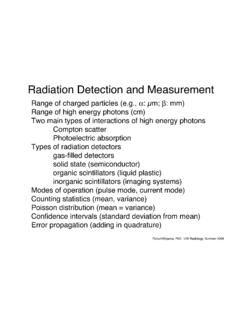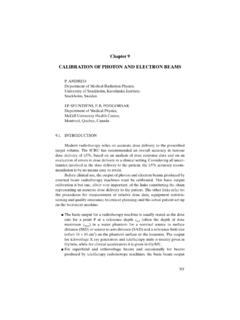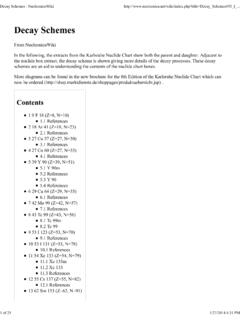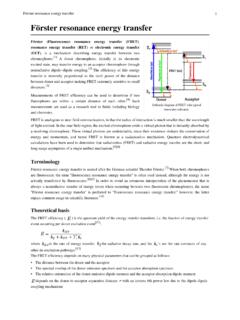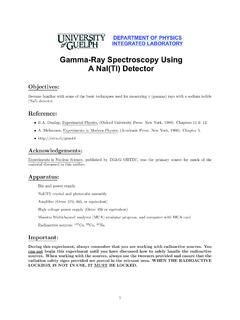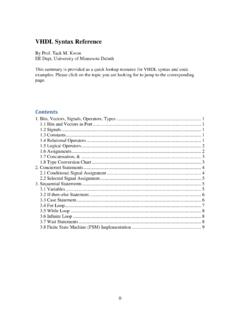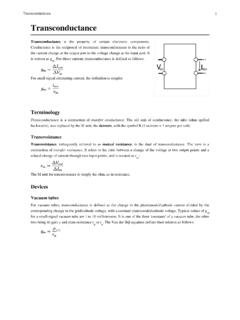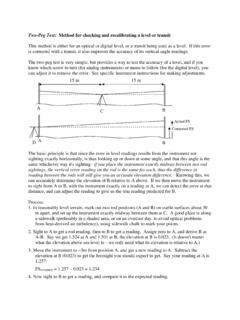Transcription of Basic Principles of Inertial Navigation
1 1 Basic Principles of Inertial NavigationSeminar on Inertial Navigation systemsTampere University of Technology2 The five Basic forms of Navigation Pilotage, which essentially relies on recognizing landmarks to know where you are. It is older than human kind. Dead reckoning, which relies on knowing where you started from plus some form of heading information and some estimate of speed. Celestial Navigation , using time and the angles between local vertical and known celestial objects ( , sun, moon, or stars). Radio Navigation , which relies on radio frequency sources with known locations (including GNSS satellites, LORAN C, Omega, Tacan, US Army Position Location and Reporting ) Inertial Navigation , which relies on knowing your initial position, velocity, and attitude and thereafter measuring your attitude rates and accelerations.
2 The operation of Inertial Navigation systems (INS) depends upon Newton s laws of classical mechanics. It is the only form of Navigation that does not rely on external references. These forms of Navigation can be used in combination as well. The subject of our seminar is the fifth form of Navigation Inertial few definitions Inertiais the property of bodies to maintain constant translational and rotational velocity, unless disturbed by forces or torques, respectively (Newton s first law of motion). An Inertial reference frameis a coordinate frame in which Newton s laws of motion are valid. Inertial reference frames are neither rotatingnor accelerating. Inertial sensorsmeasure rotation rateand acceleration, both of which are vector valued variables.
3 Gyroscopesare sensors for measuring rotation: rate gyroscopesmeasure rotation rate, and integrating gyroscopes(also called whole angle gyroscopes) measure rotation angle. Accelerometersare sensors for measuring acceleration. However, accelerometers cannotmeasure gravitational acceleration. That is, an accelerometer in free fall (or in orbit) has no detectable input. The input axisof an Inertial sensor defines which vector component it measures. Multi axis sensorsmeasure more than one component. An Inertial measurement unit(IMU)or Inertial reference unit(IRU)contains a cluster of sensors: accelerometers(three or more, but usually three) and gyroscopes(three or more, but usually three). These sensors are rigidly mounted to a common base to maintain the same relative principle of Inertial Navigation Given the ability to measure the acceleration of vehicle it would be possible to calculate the change in velocity and position by performing successive mathematical integrations of the acceleration with respect to time.
4 In order to navigate with respect to our Inertial reference frame, it is necessary to keep track of the direction in which the accelerometers are pointing. Rotational motion of the body with respect to Inertial reference frame may be sensed using gyroscopic sensors that are used to determine the orientation of the accelerometers at all times. Given this information it is possible to resolve the accelerations into the reference frame before the integration process takes does an INS consist of? An Inertial navigationuses gyroscopes and accelerometers to maintain an estimate of the position, velocity, and attitude rates of the vehicle in or on which the INS is carried, which could be a land vehicle, aircraft, spacecraft, missile, surface ship, or submarine.
5 An INS consists of the following: An IMU Instrument support electronics Navigation computers (one or more) calculate the gravitational acceleration (not measured by accelerometers) and doubly integrate the net acceleration to maintain an estimate of the position of the host Platform and Strapdown Technologies There are many different designs of INS with different performance characteristics, but they fall generally into two categories: gimbaled or stabilized platform techniques, and strapdown The original applications of INS technology used stable platform techniques. In such systems, the Inertial sensors are mounted on a stable platform and mechanically isolated from the rotational motion of the vehicle. Platform systems are still in use, particularly for those applications requiring very accurate estimates of Navigation data, such as ships and submarines.
6 Modern systems have removed most of the mechanical complexity of platform systems by having the sensors attached rigidly, or strapped down , to the body of the host vehicle. The potential benefits of this approach are lower cost, reduced size, and greater reliability compared with equivalent platform systems. The major disadvantage is a substantial increase in computing complexity. Gimbaled Inertial platform8 Gimbaled systems A gimbal is a rigid with rotation bearings for isolating the inside of the frame from external rotations about the bearing axes. At least three gimbals are required to isolate a subsystem from host vehicle rotations about three axes, typically labeled roll, pitch, and yawaxes. The gimbals in an INS are mounted inside one another.
7 Gimbals and torque servos are used to null out the rotation of stable platform on which the Inertial sensors are does gimbaled INS work? The gyros of a type known as integrating gyros give an output proportional to the angle through which they have been rotated Output of each gyro connected to a servo motor driving the appropriate gimbal, thus keeping the gimbalin a constant orientation in Inertial space The gyros also contain electrical torque generators which can be used to create a fictitious input rate to the gyros Applications of electrical input to the gyro torque generators cause the gimbaltorque motors/servos to null the difference between the true gyro input rate and the electrically applied bias rate.
8 This forms a convenient means of cancelling out any drift errors in the gyro. Gimbaled INS exampleStrapdown INSS trapdowninertial Navigation concept Accelerometers mounted directly to airframe (strapdown) and measure body acceleration Horizontal/vertical accelerations computed analytically using direction cosine matrix (DCM) relating body coordinated and local level Navigation coordinates DCM computed using strapdown body mounted gyro outputsRLG instrument cluster (Marconi FIN3110 strapdown INS)14 Two dimensional Navigation for stabilized platform15 Two dimensional Navigation for strapdownsystemStrapdown Inertial Navigation unit block diagramStrapdownINS building blocks17 Accuracy vs. price1819 Advantages of INS It is autonomous and does not rely on any external aids or visibility conditions.
9 It can operate in tunnels or underwater as well as anywhere else. It is inherently well suited for integrated Navigation , guidance, and control of the host vehicle. Its IMU measures the derivatives of the variables to be controlled ( , position, velocity, and attitude). It is immune to jamming and inherently stealthy. It neither receivers nor emits detectable radiation and requires no external antenna that might be detectable by of INS Mean squared Navigation errors increase with time. Cost, including: Acquisition cost, which can be an order of magnitude (or more) higher than GPS receivers. Operations cost, including the crew actions and time required for initializing position and attitude. Time required for initializing INS attitude by gyrocompass alignment is measured in minutes.
10 TTFF for GPS receivers is measured in seconds. Maintenance cost. Electromechanical avionics systems ( , INS) tend to have higher failure rates and repair cost than purely electronic avionics systems ( , GPS). Size and weight, which have been shrinking Power requirements, which have been shrinking along with size and weight but are still higher than those for GPS receivers. Heat dissipation, which is proportional to and shrinking with power with GPS GPS integration has not only made Inertial Navigation platform better, it made it cost less Sensor errors that were unacceptable for stand alone INS operation became acceptable for integrated operation Manufacturing and calibration costs for removing these errors could be eliminated New low cost MEMS sensor technologies could be applied INS also benefits GPS performance by carrying the Navigation solution during loss of GPS signals and allowing rapid re aquisition22 Relation to guidance and control Navigationis concerned with determining where you are relative to where you want to be.
